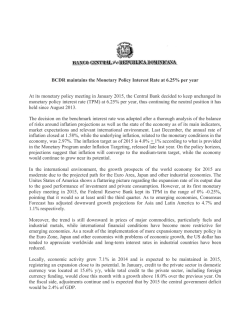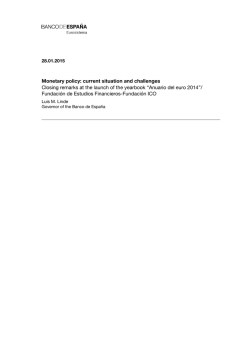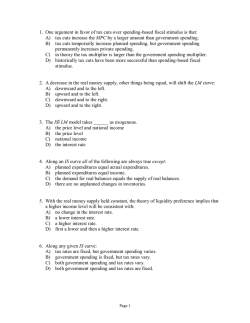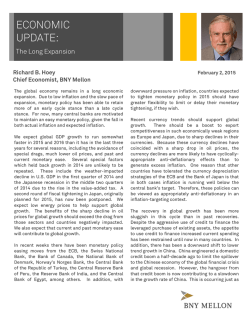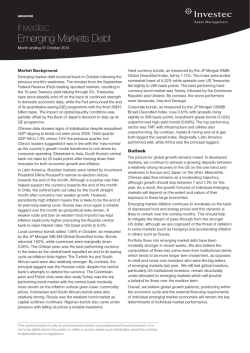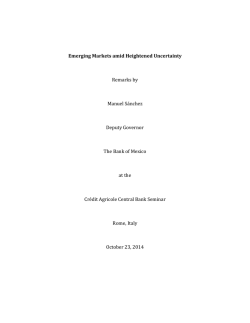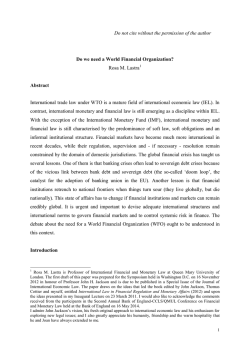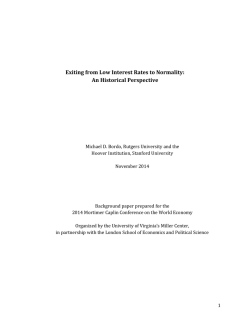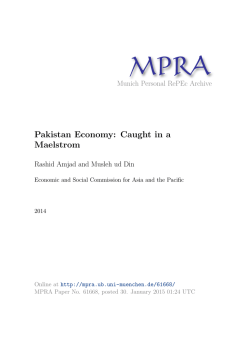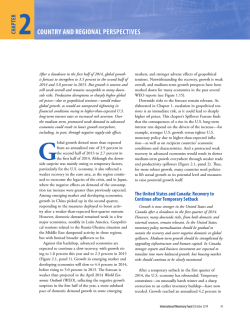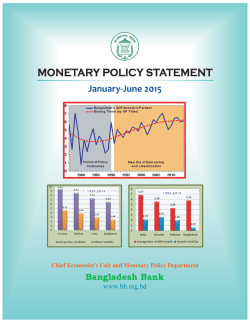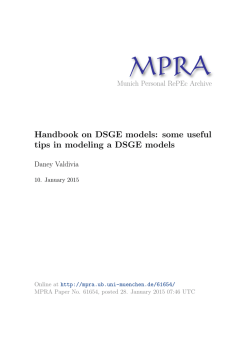
Presentación de PowerPoint - Banco de México
Monetary Policy Implementation During US Policy Normalization Javier Guzmán Calafell, Deputy Governor, Banco de México JP Morgan Investor Seminar Washington, DC, 10 October 2014 1 Outline 1 Introduction 2 Monetary Policy in 2014-15 a. The External Environment b. Domestic Conditions 3 Beyond 2015 Monetary Policy Implementation During US Policy Normalization 2 Since 2001, monetary policy in Mexico is implemented under an inflation targeting regime. In this context: A permanent inflation target of 3 percent, with a variability interval of +/- 1 percent, has been set. A systematic analysis of inflation and its determinants is carried out, on the basis of a wide range of indicators and tools. The efficient convergence of inflation to the target (i.e. at the lowest possible cost in terms of economic activity) is sought. It is also worth noting that in the aftermath of the global financial crisis, the Banco de México, in coordination with other authorities, is attaching increasing relevance to financial stability. Monetary Policy Implementation During US Policy Normalization 3 With the support of major efforts on the fiscal side, such a strategy has allowed continued progress in the reduction of inflation… Headline Inflation and Overnight Interbank Interest Rate Annual % Sep Introduction of inflation targeting 60 9 Sep 8 50 7 Overnight interbank interest rate1/ 40 6 5 30 4 20 3 Headline inflation Headline inflation 2 10 1 2014 2013 2012 2011 2010 2009 0 2008 1993 1994 1995 1996 1997 1998 1999 2000 2001 2002 2003 2004 2005 2006 2007 2008 2009 2010 2011 2012 2013 2014 0 Source: Banco de México. 1/ Target for the overnight interbank interest rate adopted on 21 January 2008. Monetary Policy Implementation During US Policy Normalization 4 …and to maintain stable medium and long term inflation expectations even in the presence of substantial shocks. Inflation Expectations and Inflation Shocks Annual % 60 16 Sep 50 MXN/USD Exchange Rate Fruits and Vegetables 40 14 Inflation Expectations: 12 months 2 years 4 years 12 2014 2013 2012 2011 2010 0 2009 -20 2008 2 2007 -10 2006 4 2005 0 2004 6 2003 10 2002 8 2001 20 2000 10 1999 30 Sources: Banco de México and INEGI. Monetary Policy Implementation During US Policy Normalization 5 Outline 1 Introduction 2 Monetary Policy in 2014-15 a. The External Environment b. Domestic Conditions 3 Beyond 2015 Monetary Policy Implementation During US Policy Normalization 6 Since Mexico´s economy is very open, the implementation of monetary policy is heavily influenced by external developments. Trade Openness Exports and Imports as % of GDP, 2013 63.4 Financial Openness Chinn-Ito Index1/, 2012 90 1.0 80 0.9 70 0.8 0.69 0.7 60 0.6 50 0.5 40 0.4 Source: Own calculations with data from World Economic Outlook and Direction of Trade Statistics, IMF. 0.3 S. Africa China India Colombia Indonesia Brazil Poland 0.0 Turkey 0 Russia 0.1 Chile 10 Mexico 0.2 Korea 20 Peru Brazil Colombia Russia India Indonesia China Peru Turkey Chile Mexico S. Africa Poland Korea 30 1/ Measures a country's degree of de jure capital account openness (0-1 scale), based on the IMF's Annual Report on Exchange Arrangements and Exchange Restrictions (AREAER). Source: Chinn and Ito (2006) : "What Matters for Financial Development? Capital Controls, Institutions, and Interactions“, JDE 81(1):163-192 (October). Monetary Policy Implementation During US Policy Normalization 7 The recent behavior of the world economy and its projected evolution for the rest of 2014 and in 2015 favors the expansion of Mexican exports. Major Economies: Real GDP Index 4Q-2007 = 100, s.a. 200 2Q 2014 109 Mexican Exports by Country of Destination % of Total, 2013 Japan, 0.6 China, 1.7 U.K., 0.4 China 150 104 Eurozone, 4.4 United States Japan Canada, 2.8 100 100 50 Other, 11.4 Eurozone 96 U.S., 78.8 United Kingdom s.a./ Seasonally adjusted. Source: Haver Analytics. 2014 2013 2012 2011 2010 2009 2008 2007 2006 91 2005 0 Source: INEGI. Monetary Policy Implementation During US Policy Normalization 8 In particular, analysts estimate US GDP growth above potential. US: Real Gross Domestic Product Quarterly annualized rate, s.a. Gross Domestic Product Potential GDP1/ 6 Forecast 4 2 0 -2 IV 2015 III 2015 II 2015 I 2015 IV 2014 III 2014 II 2014 I 2014 IV 2013 III 2013 II 2013 I 2013 -4 s.a./ Seasonally adjusted. 1/ Mid-point of the central tendency interval of FOMC participants’ projections for the long-run change in real GDP. Sources: BEA , Federal Reserve and Blue Chip. Monetary Policy Implementation During US Policy Normalization 9 On the other hand, the expected increase in interest rates in the US will pose additional challenges for monetary policy in Mexico and other emerging market economies. Risks are enhanced by the continued search for yield… Volatility indexes for selected financial assets Basis points Yield to maturity of selected fixed income securities Percent United States 300 18 80 23% 27% 16 70 200 14 60 12 50 2 0 0 Commodity index 4/ Source: Banco de México with data from Bloomberg 1/ MOVE (Merrill Option Volatility Estimate). 2/ VIX(“CBOE Volatility Index”). 3/ CVIX: 3-month implicit volatility of the most operated currencies. 4/ Actual volatility of the CRB index (index composed of 19 commodity futures contracts). 10-year range Corporate high yield* 10 Corporate BBB 4 Corporate AAA 20 Agencies Currency index 3/ 10-year range 6 MBS S&P 500 2/ 30 ABS 0 8 Corporate high yield* 50 40 Corporate BBB 100 10 Corporate AAA 150 Current (8-Oct-14) Europe 90 250 Treasury notes 1/ Percent Current (7-Oct-14) Source: Bank of America - Merrill Lynch. *Bonds with credit rating lower than BBB-. Monetary Policy Implementation During US Policy Normalization 10 … and the fact that markets seem to be overly optimistic about the pace of interest rate adjustments in the US. 3.0 FFR Futures 30-Jun-14 FFR Futures 08-Oct-14 2.5 Source: Bloomberg and FOMC Economic Projections. Dec-16 Sep-16 Jun-16 Mar-16 2.0 Dec-15 Sep-15 Jun-15 Mar-15 Dec-14 Sep-14 Median FOMC Dec-13 Median FOMC Mar-14 Median FOMC Jun-14 Median FOMC Sep-14 Federal Funds Rate Implicit in the OIS1/ Curve and FOMC Projections % 3.0 FFR implicit in OIS curve 2.5 Median FOMC Dec-13 Median FOMC Mar-14 Median FOMC Jun-14 Median FOMC Sep-14 2.0 1.5 1.5 1.0 1.0 0.5 0.5 0.0 0.0 Jun-12 Sep-12 Dec-12 Mar-13 Jun-13 Sep-13 Dec-13 Mar-14 Jun-14 Sep-14 Dec-14 Mar-15 Jun-15 Sep-15 Dec-15 Mar-16 Jun-16 Sep-16 Dec-16 Federal Funds Rate Futures and FOMC Projections % Source: FOMC’s projections and own calculations with data from Bloomberg. 1/ Overnight Index Swap. Monetary Policy Implementation During US Policy Normalization 11 However, it is important to note that markets have differentiated across countries. Emerging Markets: Credit Default Swaps 1/ Index 01-Jan-2013 = 100 230 2014 Russia Brazil Oct 210 Turkey 190 170 150 S. Africa 130 Peru Chile 110 90 Korea Colombia Poland 70 Mexico Oct-14 Jul-14 Apr-14 Jan-14 Oct-13 Jul-13 Apr-13 Jan-13 50 1/ 5-year CDS. Source: Bloomberg, with data through 8 October 2014. Monetary Policy Implementation During US Policy Normalization 12 Outline 1 Introduction 2 Monetary Policy in 2014-15 a. The External Environment b. Domestic Conditions 3 Beyond 2015 Monetary Policy Implementation During US Policy Normalization 13 Economic activity showed clear signs of recovery during the first half of 2014. Real Gross Domestic Product Annual % and Quarterly Annualized Rate, s.a. 6 5.2 5.0 3.9 4.0 4.2 3.2 3.1 1.4 1.4 1.8 4 2 0 -2 -4 -4.7 II-2014 I-2014 2013 2012 2011 2010 2009 2008 2007 2006 2005 -6 s.a./ Seasonally adjusted. Source: INEGI. Monetary Policy Implementation During US Policy Normalization 14 Exports were the main factor behind the expansion of economic activity, but a revival of domestic demand was also observed… Aggregate Supply and Demand Quarterly %, s.a. 6 2014-II 2014-I 3.9 1.7 1.4 1.0 4 2 0.2 0.1 0 -1.2 -2 -4 -6 -8 GDP Imports Private Govt. Private Consumption Consumption Investment Govt. Investment Exports s.a./ Seasonally adjusted. Source: Banco de México and INEGI. Monetary Policy Implementation During US Policy Normalization 15 …which has continued in more recent months. 1,400 Aug Sep 1,300 1,100 130 1,000 120 900 110 Domestic Sales of Light Vehicles 800 700 s.a. / Seasonally adjusted data. Source: Banco de México with data from INEGI. 100 95 100 Construction 90 90 s.a. / Seasonally adjusted data. 1/ Excludes oil and automobile imports. Source: Banco de México and AMIA (Mexican Association of the Automobile Industry). 2014 2013 2012 85 2011 2014 2012 2011 2010 80 2009 600 2008 2014 2013 2012 2011 2010 2009 2008 110 Total 140 2013 114 110 105 Imports of Consumption Goods 1,200 118 Jul 150 126 122 160 2010 130 2009 Jul Gross Fixed Investment Index 2008 = 100, s.a. 2008 Retail Sales Index 2003=100, s.a. Imports of Consumption Goods 1/ and Domestic Sales of Light Vehicles Index 2007 = 100 and Thousands of annualized units, s.a. s.a./ Seasonally adjusted data. Source: INEGI. Monetary Policy Implementation During US Policy Normalization 16 Nonetheless, substantial slack persists. National and Urban Unemployment Rates % of EAP, s.a. Aug Urban Output Gap % of potential output, s.a. 8 2Q-14 July 8 6 4 7 GDP 2 0 6 -2 -4 IGAE 5 National -6 -8 4 -10 -12 -14 EAP/ Economically Active Population. s.a./ Seasonally adjusted. Source: National Employment Survey (Encuesta Nacional de Ocupación y Empleo), INEGI. 2014 2013 2012 2011 2010 2009 2008 2007 2006 2005 2004 2014 2013 2012 2011 2010 2009 2008 2007 3 s.a./ Calculated with seasonally adjusted data. Note: The shaded area is the 95% confidence interval of the output gap. Source: Calculated by Banco de México with data from INEGI. Monetary Policy Implementation During US Policy Normalization 17 In the case of inflation, some upward pressures have been observed recently. Consumer Price Index Annual % Sep 8 7 Headline 6 5 4 3 Core 2 1 2014 2013 2012 2011 2010 2009 2008 2007 2006 2005 2004 2003 2002 2001 0 Sources: Banco de México and INEGI. Monetary Policy Implementation During US Policy Normalization 18 However, they result from factors of a temporary nature, and are not demand-driven. Core Inflation Annual % Non-Core Inflation Annual % 25 20 Sep Core Food, Beverage and Tobacco Air Transportation Sep Non-core Livestock 20 15 15 10 5 10 0 -5 5 -10 -15 0 -20 Sources: Banco de México and INEGI. 2014 2013 2012 2011 2010 -5 2009 2014 2013 2012 2011 2010 2009 -25 Sources: Banco de México and INEGI. Monetary Policy Implementation During US Policy Normalization 19 Consequently, medium and long term inflation expectations remain well anchored. Headline Inflation Expectations Median, % End of 2014 Sep Oct Next 4 and 5-8 Years End of 2015 4.5 Sep Oct 4.5 Sep 4.5 Banco de México 4.0 4.0 4.0 Banco de México Next 4 Years Next 5-8 Years Sep-14 Feb-14 Jul-13 Dec-12 May-12 Oct-11 Mar-11 Aug-10 Jan-10 Oct-14 2.5 Aug-14 2.5 Jun-14 2.5 Apr-14 3.0 Feb-14 3.0 Dec-13 3.0 Oct-13 Oct-14 Jul-14 Apr-14 Jan-14 Banamex Oct-13 Jul-13 Apr-13 Jan-13 3.5 3.5 3.5 Banamex Sources: Banco de México’s Survey, monthly. Last observation: September 2014. Banamex Survey, bi-weekly. Last observation: 7 October 2014. Monetary Policy Implementation During US Policy Normalization 20 Looking forward: • Strong external demand; • Expansionary monetary policy; • Fiscal stimulus; and • Increasing levels of confidence. … give support to Banco de México’s expectation of 2-2.8% GDP growth in 2014 and 3.2-4.2% in 2015, implying an expansion above potential in 2H-2014 and in 2015. Monetary Policy Implementation During US Policy Normalization 21 A strong cyclical upturn during the rest of this year and the next is expected to coincide with the convergence of inflation to the 3% target in 2015 given: 1. A negative although gradually closing output gap. 2. Gasoline price increases based on inflation expectations. 3. A favorable base effect after the tax reform. Monetary Policy Implementation During US Policy Normalization 22 This scenario is subject to a number of risks: 1. Uncertainty related to estimates of the output gap. 2. Faster closing of the output gap if the recovery of economic activity is stronger than currently foreseen. 3. Additional shocks deriving from the behavior of non-core inflation or other factors. Monetary Policy Implementation During US Policy Normalization 23 Monetary policy normalization in the US represents another risk for the Mexican economy. • Increased financial market volatility and uncertainty. • Tighter external financing. • Potential impact on peso exchange rate and inflation. Risks have increased as the beginning of interest rate hikes draws closer. Monetary Policy Implementation During US Policy Normalization 24 The Mexican economy has solid macroeconomic and financial stability bases to resiliently sail through the process. Strong macroeconomic position: • Credible monetary and fiscal policies. • Flexible exchange rate regime. • Low current account deficit. • Record high international reserves. • FCL with the IMF. • Relatively low public debt. Financial stability in the context of enhanced policy framework. Favorable growth prospects after a major structural reform effort: • Labor markets: November 2012. • Education: September 2013. • Financial sector: January 2014. • Competition: May 2014. • Telecommunications: July 2014. • Energy: August 2014. Monetary Policy Implementation During US Policy Normalization 25 Outline 1 Introduction 2 Monetary Policy in 2014-15 a. The External Environment b. Domestic Conditions 3 Beyond 2015 Monetary Policy Implementation During US Policy Normalization 26 Beyond 2015 Inflation targeting has proved its merits in Mexico and other countries before, during and in the aftermath of the global financial crisis. However, the crisis has highlighted a number of issues whose implications for inflation targeting regimes will have to be carefully assessed. One of them is the need to better understand the role of monetary policy and other instruments in preserving financial stability. Nonetheless, this does not imply a substantial modification of the fundamental structure of these regimes, nor does it raise question marks on their usefulness to anchor inflation expectations. Monetary Policy Implementation During US Policy Normalization 27 Beyond 2015, monetary policy is likely to operate in an environment characterized by world economic growth below that observed before the crisis... GDP Growth Projections Annual % 8 7 China 6 5 4 United States 3 United Kingdom 2 1 Japan Eurozone 0 2019 2018 2017 2016 2015 2014 2013 -1 Source: IMF’s World Economic Outlook, October 2014. Monetary Policy Implementation During US Policy Normalization 28 …and an upward trend in international interest rates, which underlines the importance of strengthening the domestic sources of growth. Federal Funds Rate Annual % 4.0 3.5 Federal Funds Rate FOMC OIS-implied Futures Blue Chip 3.0 2.5 2.0 1.5 1.0 0.5 2025 2024 2023 2022 2021 2020 2019 2018 2017 2016 2015 2014 2013 2012 2011 0.0 Sources: FOMC, Bloomberg and Blue Chip. Monetary Policy Implementation During US Policy Normalization 29 Even before considering the key measures approved in 2014 (financial, competition, telecommunications and energy), Mexico’s efforts of structural reform were deemed to be among the most ambitious in the world. Contrary to other experiences, this was not propelled by an economic crisis. Economic Reform Responsiveness Share of OECD reform recommendations with significant action taken during 2012-2013 0.9 0.8 0.7 0.57 0.6 0.5 0.4 0.3 0.2 0.1 CHE NOR TUR CZE USA FRA KOR AUS AUT BEL CHL DEU NLD SWE POL FIN JPN SVK CAN EST LUX SVN NZL ITA GRC HUN IRL ISR MEX PRT DNK GBR ESP 0.0 Source: Own calculations based on results presented in OECD (2014), Going for Growth Interim Report, February. Monetary Policy Implementation During US Policy Normalization 30 The latter should allow the economy to grow at faster rates without pressures on prices. More flexible and competitive product and input markets More efficient resource allocation More and better human and physical capital More incentives for technological change Stronger institutional framework Productivity gains Higher economic growth Lower inflationary pressures Main challenges: adequate implementation of structural reforms, tackling other major structural obstacles to growth, continuous strengthening of economic fundamentals. Monetary Policy Implementation During US Policy Normalization 31 32
© Copyright 2026
